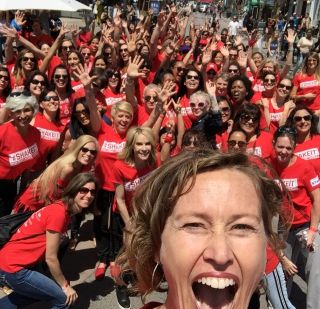Narcissism
Dying by Selfie, Believe It or Not
A snapshot of what, how, and why people die due to selfies.
Posted April 2, 2024 Reviewed by Michelle Quirk
Key points
- Hundreds have died while trying to capture an impressive selfie.
- Reasons behind risky selfies include narcissistic tendencies and need for self-identification and expression.
- With eating disorders, people are literally and figuratively killing themselves to nail that perfect picture.
I mentioned that I was researching selfie deaths to a younger friend. One brow raised, and the other furled in confusion. They said, "What?" I explained that people had died trying to capture a spectacular selfie. With a tone of confusion and disbelief, they responded, “How?”

“Cause of death: Selfie” understandably seems ridiculous and implausible. Yet, think about viral selfies you’ve seen that do not involve celebrities. Many involved risk. I recall a shot taken close to an erupting volcano and another underwater with a shark over their shoulder. There have been numerous selfies with views from the tops of skyscrapers and waterfalls. Get the picture?
One study (Bansal et al., 2018) documented 259 selfie-related deaths between October 2011 and November 2017. The mean age of those who died was around 23 years. Males made up a majority—around three-quarters—of the selfie-victims. The age groups of 10-19 and 20-29 years showed particularly high casualties and incidents.
A later study (Kang-Auger et al., 2023) showed that rates of selfie deaths steadily increased up until COVID-19 struck. Then, during the pandemic, the number of selfie deaths decreased from around four per month to one per month. Still, from March 2014 to April 2021, 332 perished while striving for that perfect shot. In this later research, instead of males comprising the majority of selfie deaths, females did instead.
Before the pandemic, drownings were the number one cause of death while clicking selfies. During COVID-19 and the lockdowns, falls (such as from waterfalls, cliffs, bridges, etc.) shifted into first place. Furthermore, Bansal et al. (2018) highlighted that mortalities also occur via animals, electrocutions, fires, firearms, transport, and other means.
In 2016, Rolling Stone (Lovitt) detailed selfie-death causes ranging from freak accidents to risk-taking. A few examples follow:
- Lightning struck a metal selfie stick, electrocuting the selfie-taker.
- While attempting a selfie with a walrus, the one-and-a-half-ton animal drowned the selfie-taker.
- During a group selfie, a wave hit. Some were injured; one was swept away and drowned.
- A selfie prop (a live grenade) unexpectedly exploded. The phone and selfie survived, but the two selfie-takers didn't.
- While positioning a pose atop a train, the selfie-taker’s leg hit a live wire. They burst into flames.
- A pilot did a selfie shoot while flying a plane–it crashed. The pilot died.
- A couple went for that edge-of-a-tall-cliff selfie. One step too far plunged them to their deaths. Their very young children watched it happen.
A study by Lamba and colleagues (2016) reviewed potential explanations behind risky selfies, which their paper termed “killfies.” Some of the reasons may include the following:
- Desire for self-expression
- Narcissistic tendencies
- Need for self-identification and expression
- Drive to increase social currency via likes, shares, and comments
Then, there are group selfie shots. You know the old saying, “If your friends were jumping off a cliff, would you do it too?" When it comes to selfies, the answer is yes. How do we know? The number of incidents of selfie deaths is lower than the number of dead selfie-takers (e.g., 259 deaths for 137 incidents [Bansal et al., 2018]). That means groups of folks decide to risk their lives together. I believe that spontaneity, impulsivity, and FoMO likely contribute to explaining the difference.
Causes of death don’t typically list “selfie,” so the number of deaths documented may be underreported at this time. I wonder about car accidents when I witness selfie stills or videos filmed while driving.
Also, I think about eating disorders and selfies. Some people are killing themselves via their eating disorders. And social media, which is a way of life now, often fuels the eating disorder. It may not be a traditional risk like dangling their feet off a skyscraper and snapping a shot, but many in our society are literally and figuratively killing themselves to nail that perfect picture.
References
Bansal, A., Garg, C., Pakhare, A., & Gupta, S. (2018). Selfies: A boon or bane? Journal of Family Medicine and Primary Care, 7(4), 828–831. https://doi.org/10.4103/jfmpc.jfmpc_109_18
Kang-Auger, S., Lewin, A., Ayoub, A., Bilodeau-Bertrand, M., Marcoux, S., & Auger, N. (2023). Social Media and Selfie-Related Mortality Amid COVID-19: Interrupted Time Series Analysis. JMIR Formative Research, 7, e42857. https://doi.org/10.2196/42857
Lamba, H., Bharadhwaj, V., Vachher, M., Agarwal, D., Arora, M. & Kumaraguru, P. (2016). Me, myself, and my killfie: Characterizing and preventing selfie deaths. ArXiv. https://arxiv.org/abs/1611.01911
Lovitt, B. (2016, July 14). Death by selfie: 11 disturbing stories of social media pics gone wrong. Rolling Stone.


